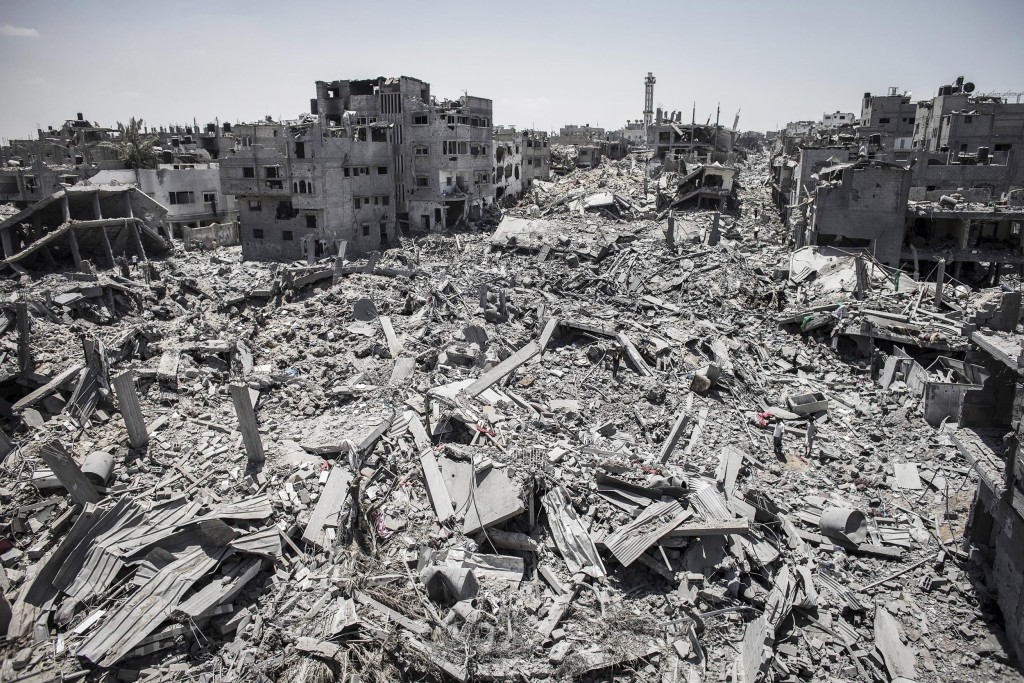 Op-Ed by Emily Thompson
Op-Ed by Emily Thompson
Gaza is currently under an intense bombing campaign as Israel fights to save its hostages and kill Hamas terrorists. In doing so, Israel’s Air Force and artillery have wiped out any building or location they say Hamas used as a location from which to carry out its terror activities.
At the moment, many neighborhoods in several Gazan cities, communities, and refugee camps are completely destroyed. The most important thing now is to ensure that after this war is over, the Palestinians who escaped to the south of Gaza and have now lost their home, will be able to return to a newly rebuilt one.
To ensure this, the international community, together with Egypt, the Palestinian Authority and Israel should begin immediately to draw up reconstruction plans – a new kind of Marshall Plan – to reconstruct the Gaza Strip. With Hamas gone, Palestinian civilians will no longer be required to live under the strict, oppressive terror regime and will be free to live their lives as they please and with a brighter future.
But for this to happen, nations must come together and act upon the decades of pledges and promises to the Palestinians to help them achieve a safe and secure future.
According to the Arab Center Washington DC, “Billions of dollars have been committed to rebuilding Gaza over the decades, but conditions have only continued to deteriorate. For this and many other reasons, Gaza is most often identified today as a humanitarian disaster.
Israel’s 2014 war in Gaza was utterly catastrophic for Gaza’s civilians, and the emotional response for aid seemed to match the urgency. At a conference in Cairo months later, donors pledged $3.5 billion to rebuild Gaza over three years. Top pledges came from the United States ($277 million), the European Union ($348 million), Saudi Arabia ($500 million), and Qatar ($1 billion). Overall, donors pledged $5.4 billion (part of which went to support the budget of the Palestinian Authority [PA]).
Yet even then, donors were skeptical about the potential for any amount of money to rebuild Gaza without a just and permanent political resolution of the Palestinian question. Donors were likely reluctant to donate funds to rebuild infrastructure that was likely to be damaged again.
While the pledges were generous, the actual donations fell short. Months after the conference, less than 2 percent of the money had been transferred to the Palestinians. The Gulf states, which made the highest pledges, had the biggest shortfalls; by 2018, almost all the unfulfilled pledges were by these Arab states.
Rebuilding Gaza post-war will certainly be a multifaceted challenge that calls for a detailed and inclusive strategy. Initially, the safety of the inhabitants is paramount. This means clearing all urban and surrounding areas of war remnants like unexploded ordnance and mines, often necessitating partnerships with specialized agencies.
The next pivotal step is the restoration of infrastructure, focusing on vital utilities such as water, electricity, sanitation, and communication channels. Concurrently, roadways, bridges, and public transit systems should be revamped to ensure seamless connectivity within and outside the region.
Housing, undoubtedly, will be among the most pressing concerns as many buildings have been destroyed. While the immediate solution might lean towards temporary shelters, the long-term vision should aim at constructing durable and resilient homes.
With Hamas governance gone, the local economy will need a boost. This can be achieved by supporting local enterprises through financial aids, rejuvenating local markets, and potentially introducing new industries to offer widespread employment.
Healthcare, encompassing both physical and mental well-being, must be addressed promptly by reestablishing medical facilities and prioritizing trauma-related services. At the same time, the education sector, especially schools, should be brought back on track to secure Gaza’s future – this time without Hamas.
There are multiple layers of administrative and bureaucratic barriers needed for a reconstruction effort. Much of the money to be used in Gaza will be likely be channeled through the PA’s Ministry of Finance in Ramallah, which will need to work with the United Nations and other agencies within Gaza.
Another significant obstacle that has entrenched the blockade is the Gaza Reconstruction Mechanism (GRM) established after the 2014 war. The GRM put the United Nations at the center of a complex process meant to monitor so-called “dual use” goods imported into Gaza. Sold as a temporary measure meant to benefit Palestinians by streamlining the processes needed to import goods through a crippling blockade, as well as grant governing power to the PA.
In 2021, Qatar was quick to announce $500 million for reconstruction, while the United States pledged $360 million in total Palestinian aid, with a large chunk reserved for the United Nations Relief and Works Agency’s (UNRWA) reconstruction efforts. The European Union (and separately, Germany and Norway), the United Kingdom, and China also announced their support. Nonetheless, the UN appealed for an emergency $95 million for immediate needs such as the provision of food, health care, basic repairs, and cash assistance.
Before the last cease-fire, Egypt pledged $500 million for rebuilding efforts in Gaza, primarily through supporting Egyptian companies that will work in the besieged territory. In early June, Egypt sent convoys of approximately 50 bulldozers, cranes, and other construction vehicles to Gaza, prominently displaying the Egyptian flag. It seems clear that Sisi saw this investment as an opportunity to reposition Egypt as a regional leader and gain credit with western nations. Now, Egypt must replicate this enthusiasm and work to rebuild Gaza together with other nations.
Now is the time to start planning Gaza’s bright new future. Its citizens deserve nothing less.
Become a Patron!
Or support us at SubscribeStar
Donate cryptocurrency HERE
Subscribe to Activist Post for truth, peace, and freedom news. Follow us on SoMee, Telegram, HIVE, Minds, MeWe, Twitter – X, Gab, and What Really Happened.
Provide, Protect and Profit from what’s coming! Get a free issue of Counter Markets today.

Be the first to comment on "How to Rebuild Gaza After the War"